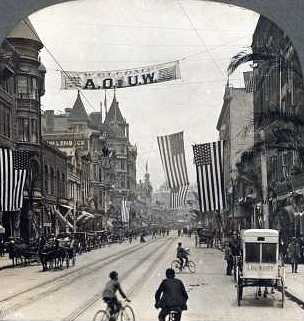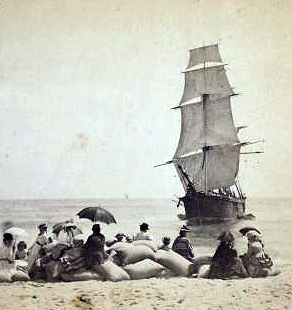by Joshua Heineman
The New York Public Library has released a new website called The Stereogranimator, which allows patrons to create their own animated files or 3-D images from the Library's collection of stereographs, a popular 19th Century photo format. The web project gives this important, historic medium new life, and also highlights the work of NYPL patron Joshua Heineman, who started creating his own moving images from Library stereograms as an art project for his blog. The Library's NYPL Labs team was so impressed it decided to build on his idea. Here's his story about how the idea took shape and grew into a Library project.

In a way, old photographs are postcards from another time. If you look through enough of them, you start to notice that many from before 1900 come in seemingly identical pairs. What you may not realize is that these pairs were meant to be viewed together, each side lending the other a sense of depth that a photograph alone cannot possess. Using stereoscopes, the entertainment-seeking public of the 19th century immersed themselves in these 3D photographs (called stereographs) in a manner akin to how we now view movies, video games or cellphone screens. Imagine the impression stereographs must have left on viewers then, considering it was the early days of photography as a medium. Perhaps it would be comparable to building the Burj Khalifa in Chicago just after George Fuller invented the skyscraper or sending the Wright brothers straight to the moon. We'll never know because, while a small number of public, coin-operated stereoscopes still survive in antique arcades such as the Musee Mechanique in San Francisco, the experience of these stereographs in their own time has been lost to history.
Yet we still have these mementos, these curious photo pairs, piled in back rooms and archives across the world. I must have nearly gone blind viewing hundreds of The New York Public Library's online collection of some 40,000 stereographs when I first found them. I knew they were stereo pairs because when I was a child my father had worked with a simple stereoscope in his profession as a forester for the Department of Natural Resources and he'd shown me how he used two aerial photographs from slightly different points in the sky to create a three-dimensional birds-eye-view of timber sales. He'd also explained how his stereoscope worked by teaching me how to view stereo pairs without the scope. For viewing the library's collection, the viewing process initially involved loading a full-screen paired image, setting the laptop on the edge of the bed and then forcing my poor eyes to focus beyond the screen until the resulting double-vision lined up and the middle gained perspective. I spent hours doing this with Muybridge's majestic pictures of the West and street scenes of old New York. Even with the difficult viewing process, the effect was startling. The photographs seemed to regain a sense of the moment that we typically do not associate with history. The people and places pictured were still lost, but somehow they felt more real and more alive in their milieu.
It was chance that changed my private interest into a years-long art project that captivated the internet (as much as such a thing can happen) and made the NYPL's new Stereogranimator, an online animated gif and anaglyph creator designed by NYPL Labs and tied to the Library's vast collection of stereographs, possible. One evening in my final year of college, I was downloading digital snapshots to my laptop when I got a fleeting sense of 3D as the preview screen flicked quickly between two similar shots. I located the individual photos and flipped back and forth between them continually. The parallax effect of minor changes between the two perspectives created a sustained sense of dimension that approximated the effect of stereo viewing. When I realized how the effect was working, I set about discovering if I could capture the same illusion by layering both sides of an old stereograph in Photoshop and displaying the result as an animated gif. The result was more jarring and more shallow than through a stereoscope but no less magic. Besides, there it was on an ordinary computer screen for anyone to experience! A few years later, when I started cursivebuildings.com, I quietly began collecting these re-enlivened stereographs from the NYPL archives under the series title Reaching for the Out of Reach. Within a month, there were 70,000 viewers a day pouring over the project, countless links and features, and emails coming in from all over the world -- including an encouraging note from a director of the Library itself. Clearly, this wasn't such a private interest after all.
A Past You Can Almost Touch & The Modern Perspective


The Bigger Picture
Reaching for the Out of Reach was ultimately a 21st century raid of the NYPL's archive of 19th century treasure. I didn't ask permission. I didn't think to ask, being under a spell of wide-eyed discovery at the time and not expecting anyone to notice. This is the sort of behavior that has led to cease-and-desist letters and lawsuits in recent years. Instead, the library seemed invigorated by the creative reuse, pointing to my project in media and in seminars as an example of a way forward for heritage institutions in the all-access jungle of modern technology. Eventually NYPL Labs, an experimental unit of the library focusing on technology and user collaboration initiatives, began work on the Stereogranimator project to give every patron -- no matter the level of technical ability or aptitude -- access to the same kind of interaction with the library's stereo collection. The only remaining requirement is curiosity. Animated gifs and anaglyphs created on the website are stored in a gallery and users are given code to share their creations elsewhere online. The shared content links to the library's page for the original stereograph, completing the cycle back at the source. This kind of mutually beneficial relationship between archivist and user would have been unthinkable even 10 years ago.
So while I'm honored my work put us on the path to reconnect with this piece of our past, I am thrilled that NYPL Labs set a precedent pointed squarely toward the future.